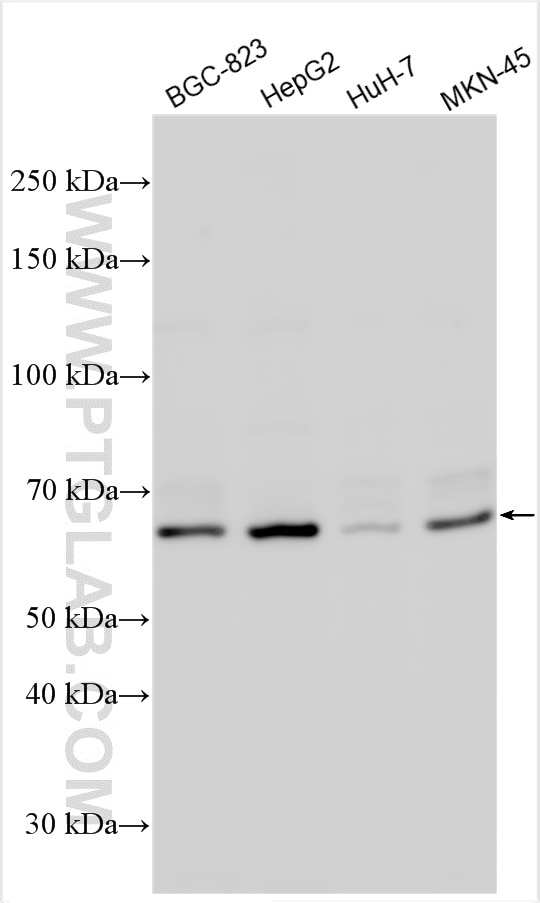GALNT1 Polyklonaler Antikörper
GALNT1 Polyklonal Antikörper für WB, ELISA
Wirt / Isotyp
Kaninchen / IgG
Getestete Reaktivität
human, Maus, Ratte
Anwendung
WB, ELISA
Konjugation
Unkonjugiert
Kat-Nr. : 21139-1-AP
Synonyme
Geprüfte Anwendungen
| Erfolgreiche Detektion in WB | BGC-823-Zellen, HepG2-Zellen, HuH-7-Zellen, MKN-45-Zellen |
Empfohlene Verdünnung
| Anwendung | Verdünnung |
|---|---|
| Western Blot (WB) | WB : 1:500-1:1000 |
| It is recommended that this reagent should be titrated in each testing system to obtain optimal results. | |
| Sample-dependent, check data in validation data gallery | |
Produktinformation
21139-1-AP bindet in WB, ELISA GALNT1 und zeigt Reaktivität mit human, Maus, Ratten
| Getestete Reaktivität | human, Maus, Ratte |
| Wirt / Isotyp | Kaninchen / IgG |
| Klonalität | Polyklonal |
| Typ | Antikörper |
| Immunogen | GALNT1 fusion protein Ag15591 |
| Vollständiger Name | UDP-N-acetyl-alpha-D-galactosamine:polypeptide N-acetylgalactosaminyltransferase 1 (GalNAc-T1) |
| Berechnetes Molekulargewicht | 559 aa, 64 kDa |
| Beobachtetes Molekulargewicht | 64 kDa |
| GenBank-Zugangsnummer | BC038440 |
| Gene symbol | GALNT1 |
| Gene ID (NCBI) | 2589 |
| Konjugation | Unkonjugiert |
| Form | Liquid |
| Reinigungsmethode | Antigen-Affinitätsreinigung |
| Lagerungspuffer | PBS with 0.02% sodium azide and 50% glycerol |
| Lagerungsbedingungen | Bei -20°C lagern. Nach dem Versand ein Jahr lang stabil Aliquotieren ist bei -20oC Lagerung nicht notwendig. 20ul Größen enthalten 0,1% BSA. |
Hintergrundinformationen
N-acetylgalactosaminyltransferase 1 (GALNT1) is a member of a large family of Golgi resident polypeptide GALNT that initiate mucin-type O-glycosylation by transfer of α-GalNAc from UDP-GalNAc to serine or threonine residues of proteins. GALNT1 is frequently up-regulated in HCC and gastric cancer, and higher GALNT1 expression levels are associated with poorer overall survival (PMID: 25730904, 36439876). The antibody against GALNT1 recognized a specific band at 64 kDa.
Protokolle
| PRODUKTSPEZIFISCHE PROTOKOLLE | |
|---|---|
| WB protocol for GALNT1 antibody 21139-1-AP | Protokoll herunterladen |
| STANDARD-PROTOKOLLE | |
|---|---|
| Klicken Sie hier, um unsere Standardprotokolle anzuzeigen |


